
The family Campanulaceae, of the order Asterales, contains nearly 2400 species in 84 genera of herbaceous plants, shrubs, and rarely small trees, often with milky sap. Among them are several familiar garden plants belonging to the genera Campanula (bellflower), Lobelia, and Platycodon (balloonflower). Campanula rapunculus and Codonopsis lanceolata are eaten as vegetables. Lobelia inflata, L. siphilitica and L. tupa and others have been used as medicinal plants. Campanula rapunculoides may be a troublesome weed, particularly in gardens, while Legousia spp. may occur in arable fields.

Pinguicula moranensis is a perennial rosette-forming insectivorous herb native to Mexico and Guatemala. A species of butterwort, it forms summer rosettes of flat, succulent leaves up to 10 centimeters (4 in) long, which are covered in mucilaginous (sticky) glands that attract, trap, and digest arthropod prey. Nutrients derived from the prey are used to supplement the nutrient-poor substrate that the plant grows in. In the winter the plant forms a non-carnivorous rosette of small, fleshy leaves that conserves energy while food and moisture supplies are low. Single pink, purple, or violet flowers appear twice a year on upright stalks up to 25 centimeters long.
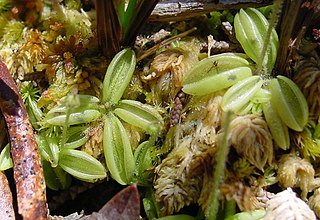
Pinguicula lusitanica, commonly known as the pale butterwort, is a small butterwort that grows wild in acidic peat bog areas along coastal atlantic western Europe from western Scotland and Ireland south through western England and western France to the Iberian Peninsula and Morocco in north-western Africa.
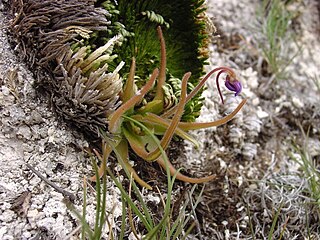
Pinguicula gypsicola is an insectivorous plant of the genus Pinguicula native to the Mexican state of San Luis Potosi, a heterophyllous member of the section Orcheosanthus. It grows in gypsum soils and forms stemless rosettes of upright, narrow leaves.
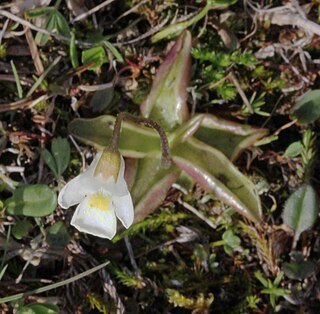
Pinguicula alpina, also known as the alpine butterwort, is a species of carnivorous plant native to high latitudes and altitudes throughout Eurasia. It is one of the most widespread Pinguicula species, being found in mountainous regions from Iceland to the Himalayas. Native to cold climates, it is a temperate species, forming prostrate rosettes of green to red leaves and white flowers in the summer and a tight hibernaculum during a period of winter dormancy in the winter. Like all members of the genus, P. alpina uses mucilaginous glands covering the surface of its summer leaves to attract, trap, and digest arthropod prey.
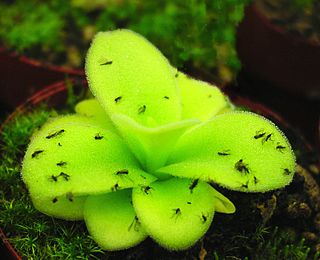
Pinguicula gigantea is a tropical species of carnivorous plant in the family Lentibulariaceae. Its native range is within Mexico. P. gigantea's flower is usually a purple colour with the occasional light blue also seen. P. gigantea was once classified as Pinguicula ayautla.

Pinguicula ramosa is a species of butterwort, a carnivorous plant, endemic to the mountains of Nikkō National Park in Japan. It belongs to the section micranthus and is closely related to Pinguicula variegata. It is unique in the genus for having a forked flower stalk.

Pinguicula acuminata is an insectivorous plant of the genus Pinguicula endemic to the Mexican state of Hidalgo, a member of the section Heterophyllum. It is notable for producing flowers while the winter rosette is buried beneath the soil surface. Described in 1839, it was not rediscovered until 150 years later.

Pinguicula vulgaris, the common butterwort, is a perennial carnivorous plant in the bladderwort family, Lentibulariaceae.

Pinguicula orchidioides is a perennial rosette-forming insectivorous herb native to Mexico and Guatemala. A species of butterwort, it forms summer rosettes of flat, succulent leaves up to 5 centimeters (2 in) long, which are covered in mucilaginous (sticky) glands that attract, trap, and digest arthropod prey. Nutrients derived from the prey are used to supplement the nutrient-poor substrate that the plant grows in. Uniquely among Pinguicula species from the Americas, p. orchidioides produces gemma-like basal buds which elongate into stolons and serve as a means of asexual reproduction. In the winter the plant forms a non-carnivorous rosette of small, fleshy leaves that conserves energy while food and moisture supplies are low. Single purple flowers appear between July and September on upright stalks up to 22 centimeters long.
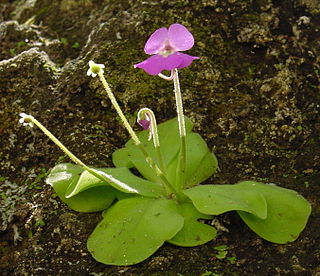
Pinguicula elizabethiae is a perennial rosette-forming insectivorous herb native to the Mexican states of Querétaro and Hidalgo. A species of butterwort, it forms summer rosettes of flat, succulent leaves up to 5 centimeters (4 in) long, which are covered in mucilaginous (sticky) glands that attract, trap, and digest arthropod prey. Nutrients derived from the prey are used to supplement the nutrient-poor substrate that the plant grows in. In the winter the plant forms a non-carnivorous rosette of small, fleshy leaves that conserves energy while food and moisture supplies are low. Single purple flowers appear between July and October on upright stalks up to 75 millimeters long.
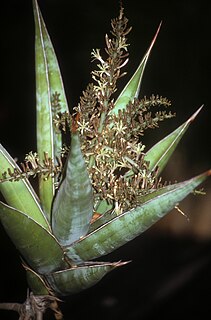
Dracaena pinguicula, synonym Sansevieria pinguicula, also known as the walking sansevieria, is a xerophytic CAM succulent native to the Bura area of Kenya, near Garissa. The species was described by Peter René Oscar Bally in 1943.

Pinguicula, commonly known as the butterworts, is a genus of carnivorous flowering plants in the family Lentibulariaceae. They use sticky, glandular leaves to lure, trap, and digest insects in order to supplement the poor mineral nutrition they obtain from the environment. Of the roughly 80 currently known species, 13 are native to Europe, 9 to North America, and some to northern Asia. The largest number of species is in South and Central America.

Lysimachia foemina is commonly known as blue pimpernel or poor man's weatherglass, and was formerly called Anagallis foemina. It is a low-growing annual herbaceous plant in the genus Lysimachia of the family Primulaceae. In a comparison of DNA sequences, L. foemina was shown to be most closely related to L. monelli. It had been thought by many to be closest to L. arvensis, and some authors had even included L. foemina as a subspecies of L. arvensis, as Anagallis arvensis subsp foemina. These three species were among several transferred from Anagallis to Lysimachia in a 2009 paper.

Pinguicula lutea, commonly known as the yellow butterwort, is a species of warm-temperate carnivorous plant in the family Lentibulariaceae. It grows in savannas and sandy bog areas of the Southeastern United States.
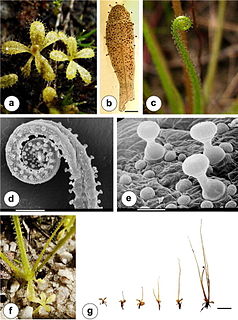
Pinguicula filifolia, is a carnivorous species of plant found predominantly in western Cuba and some of the neighboring regions. It was discovered by Charles Wright in 1866. It is a tropical plant that uses sticky secretions on its leaves to catch small insects, pollen, and other plant debris to help supplement its own nutrition. It thrives in swamp like white sand savannahs with high temperatures and humidity.
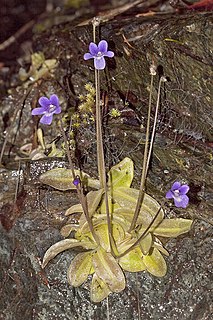
Pinguicula macroceras, the California butterwort or horned butterwort, is a species of perennial carnivorous herb that is native to the North American Pacific coast, as well as other select distributions in Canada, Russia, Japan, and the United States.[3] [7] Common names include California butterwort, horned butterwort and butterwort. Pinguicula macroceras belongs to the genus Pinguicula and the family Lentibulariaceae.

Eucalyptus boliviana, commonly known as Bolivia Hill stringybark or Bolivia stringybark is a shrub or a mallee, sometimes a small tree and is endemic to a small area in northern New South Wales. It is a stringybark with four-sides stems, broadly lance-shaped adult leaves, flower buds arranged in groups of seven, yellow flowers and hemispherical to broadly funnel-shaped fruit.
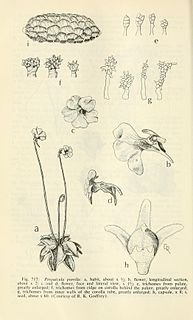
Pinguicula pumila, commonly known as the small butterwort or dwarf butterwort is a small species of carnivorous plant in the genus Pinguicula. It is native to the southeastern United States, where it grows in habitats where soil is poor in nutrition.
Pinguicula hemiepiphytica is a tropical carnivorous plant species native to the cloud forests of Oaxaca, Mexico. It was first identified in 1991 and is one of the few epiphytic species in the genus.

















